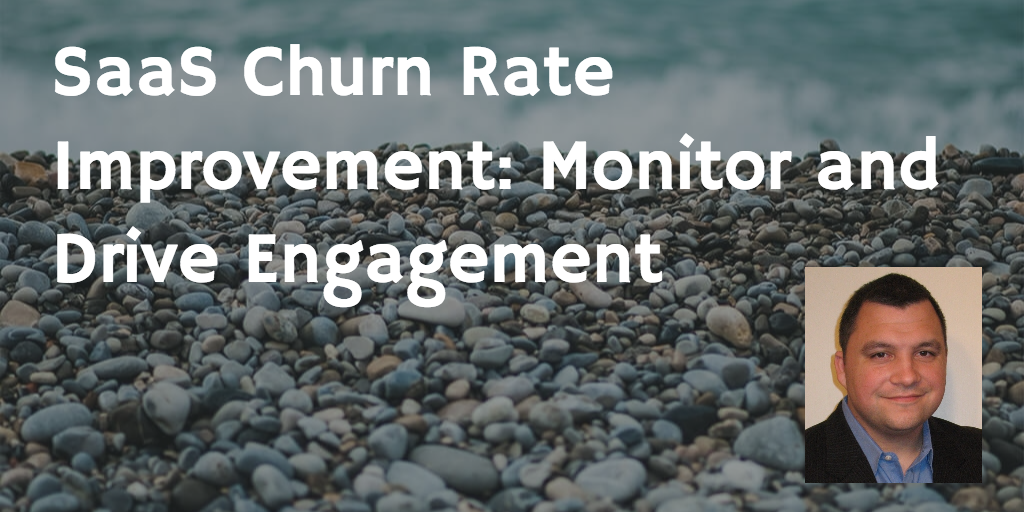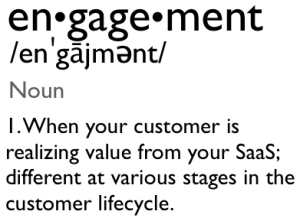 In my last post I shared some actual ways to reduce your SaaS Churn Rate, including attracting the right customer and managing expectations.
In my last post I shared some actual ways to reduce your SaaS Churn Rate, including attracting the right customer and managing expectations.
In this post, I’m going to go deeper, and share some awesome methods for improving customer retention by leveraging the power of the SaaS business model, specifically the ability of the provider to monitor for and drive Customer Engagement.
Engagement is Key to Reducing Your SaaS Churn Rate
While this post by Help Scout has some pretty great Customer Retention Strategies – including some links to awesome customer psychology research – it is somewhat typical of churn reduction posts.
Everything Help Scout said in that post was awesome and true… I just want to dig deeper into what it really takes to retain a SaaS customer.
First of all, you want customers that will actually use your SaaS… this isn’t a gym; the best SaaS customers actually show up and use your service!
And successful SaaS providers want ultra-engaged customers and users…
…but what is “engagement” in the first place?
Define: Engagement
 Engagement is a term that get’s thrown around a lot these days in the context of SaaS customer success, but if you ask 10 people to define it you’ll likely get 10 different definitions.
Engagement is a term that get’s thrown around a lot these days in the context of SaaS customer success, but if you ask 10 people to define it you’ll likely get 10 different definitions.
While I don’t expect everyone to agree with me, I want you to know how I define Engagement so you know where I’m coming from.
Engagement is when your customer is realizing value from your SaaS.
When you look at engagement that way, it completely changes everything because you look at everything differently.
Instead of thinking about engagement as a “product” issue, you can see that it is actually a customer issue.
This is what I mean when I say functional on-boarding and “engagement” aren’t the same thing; on-boarding doesn’t require engagement, but engagement probably requires functional on-boarding; it’s required but it’s not enough.
Going through the motions and taking some specific actions might be what is functionally required for the customer, but if it isn’t congruent with your customer’s success map (I’ll touch on this later), you don’t have engagement – you have a functionally on-board churn threat – and you’re in trouble!
Also, instead of thinking that engagement is this one solitary event, you can see how the customer will change what the value they realize from your service will be over time and you can adjust your “engagement process” over time, too.
It makes sense that engagement in a Free Trial is different than engagement after 6-months as a customer, right?
So once you understand what engagement is, now you need to…
Measure Engagement to Improve Your SaaS Churn Rate
Now, to measure engagement means understanding what will make the customer find success with your SaaS and ensuring they’re moving along a path that is aligned with their definition of “success” both initially and over the course of their lifetime as a customer.
While we might still measure “they did this action” or “they used this feature” at a functional level, if we look at engagement from the customer value realization standpoint, we know why they’re doing those things and that tells us whether or not they are engaged.
Just as we look at customer segments and perform cohort analysis to attract the right customers through the best channels, we need to segment customers at this stage, too, so we can accurately measure engagement.
But remember, not all customers are created equal, so what “engagement” is for one type of customer may not be the same for your other customers; it’s up to you to clearly understand the differences between customer segments!
When you look at it that way, you can see that a login, for example, is not engagement.
Engagement as a Metric to Reduce your SaaS Churn Rate
All of this means that the number of logins – often floated as a measure of “engagement”- probably isn’t a meaningful measure of engagement, right?
Well, it means that engagement might include 3 logins, but without the context of the customer’s success in mind, we can’t look at individual user activities and say that’s “engagement” or not.
In fact, with context, you might discover that 3 logins with no other activity is a potential churn threat (or a potential customer that’s not going to convert) and likely means the user wants to – but can’t figure out how to – get started! This is probably a good time to reach out or as a trigger for an email or in-app message that can help them get started.
But if you think number of logins itself – as many do but might not admit after reading this – is the same as engagement, you’d overlook a big churn threat and an opportunity to move the customer on a path to realizing value and you’d lose the customer.
And that would happen while you think that everything is fine, but still wonder why customers churn out after a short amount of time!
But just measuring engagement isn’t enough, you need to…
Drive Engagement with a Customer Success Map
The key take away from everything I’m saying here should be to focus on the customer and not your product, functionality, features, etc.
That means the way to figure out what true customer engagement looks like – and what you need to monitor, measure, and encourage – is to map out the path(s) that your customer will take during their Free Trial, over the first 30, 60, 90 days, and continue to map it out from there, keeping it tightly aligned with your customer’s idea of success.
And take it further out from there… 6-months, 1-year, etc.
No, it’s not supposed to be easy. Yes, it will require a lot of work, including digging through historical data if you’ve been in-market long enough and/or talking to customers, prospects, etc. to glean this information.
Look, if you have an estimated (or hopeful) Customer Lifetime of 36 months, how do you expect to get there in a predictable manner at scale (rather than by accident and in-spite of your efforts) if you don’t know what success looks like for your customer 35-months into their subscription?
It makes sense, right? If you don’t know (or can’t even make a realistic hypothesis about) how your customer defines – and will define – success over time, how can you actually monitor, measure, and encourage it?
You can’t, so you end up looking at events that mean nothing or have no meaningful context and trying to “improve” the process – or just ignoring it and hoping they’ll stay – all while you continue to wonder why your SaaS churn rate isn’t getting any better.
Tools to Drive Engagement: the Build vs. Buy Question
The decision to build your own system in-house to manage the process of measuring, monitoring, and encouraging engagement across the customer lifecycle vs. leveraging a third-party commercial offering depends on many factors: your available resources, the time you want to invest, what methods of communication your customers will want/respond to (email, in-app messaging, etc.), to name a few.
The beauty of third-party systems is that they get you to a live, actionable system faster; the downside is that you often have to rework your requirements to fit what is available…. but the latter is becoming less of a problem as more and more commercial offerings hit the market to tackle this opportunity.
I’m sure there are others out there – feel free to let me know what they are in the comments – but these are the providers I’m familiar with either because I’ve used them or I’ve gotten to know the company on my own to better understand what they offer.
- USERcycle
- Woopra
- Mixpanel
- Intercom.io
- Totango
- Evergage
- Klaviyo
- Userfox
- Customer.io
- Vero
- Sailthru
- Gainsight
So you have commercial options – or you can build your own – but here’s the absolute reality…
You can spend all the time, effort, and money in the world instrumenting your SaaS, hooking into third-party APIs to report on engagement, or building your own from scratch, but if you don’t have a clear picture of what actual engagement is for your customers in your SaaS and how it should change over time, it’s all for naught.
Get clear on your customer’s Success Map and then figure out what the right solution is to measure, monitor, and encourage engagement.
Then, once you’re measuring and driving engagement, you need to monitor and get proactive on Churn Threats… which I talk about in great detail in this post titled SaaS Churn Threats: Identify and Retain At-Risk Customers.



